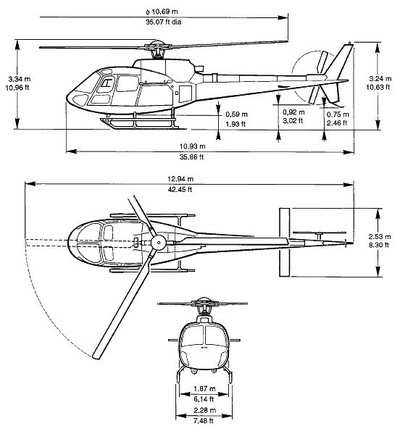Tue, Sep 30, 2008
Hydraulic Failures Can Lead To Controllability Issues
 Citing six events involving Eurocopter AS350 helicopters in the
past six years -- including two fatal crashes -- on Tuesday the
National Transportation Safety Administration issued
recommendations to the Federal Aviation Administration and European
Aviation Safety Agency to address concerns over the helicopter's
hydraulic pump drive shafts.
Citing six events involving Eurocopter AS350 helicopters in the
past six years -- including two fatal crashes -- on Tuesday the
National Transportation Safety Administration issued
recommendations to the Federal Aviation Administration and European
Aviation Safety Agency to address concerns over the helicopter's
hydraulic pump drive shafts.
Those shafts are also used in smaller EC130, the NTSB noted.
The Board recommended the FAA:
- Require Eurocopter to identify AS-350 and EC-130 helicopter
hydraulic pump drive shafts and coupling sleeves with splines that
do not meet design specifications and take appropriate action to
ensure that these parts (that is, replacement parts and parts to be
installed in new helicopters) are expeditiously removed from the
supply chain. (A-08-75)
- Require operators of Eurocopter AS-350 and EC-130 helicopters
to perform a wear check, visual inspection, and lubrication of the
hydraulic power assembly splines and coupling sleeve splines in
accordance with the latest version of the maintenance manual at the
earliest opportunity, and, thereafter, require operators to repeat
the wear check, visual inspection, and lubrication of the splined
connection at 100-hour intervals, and remove unairworthy parts from
service. (A-08-76)
The same recommendations were also made to EASA, under A-08-77
and A-08-78, respectively.
"The Safety Board Materials Laboratory examined parts of the
helicopters involved in these events, specifically the hydraulic
pump assembly and pulley assembly that provide all the hydraulic
power for the main rotor controls and the tail rotor controls," the
NTSB notes. "Staff found that the splined connection that couples
the hydraulic pump to its pulley assembly displayed excessive wear
that in some cases caused it to fail with subsequent loss of
hydraulic power. Loss of hydraulic power hinders helicopter control
and increases the possibility of a serious accident...

"The helicopter can be flown without hydraulic power (that is,
in manual mode) but doing so increases the physical demands on the
pilot and can cause a serious accident if the pilot has not
maintained familiarity with operation of the helicopter in manual
mode or if an uncommanded reversion to manual mode occurs suddenly,
especially during a critical maneuver."
FMI: Read The NTSB Recommendations Here And Here
(.pdf)
More News
Light Gun A handheld directional light signaling device which emits a brilliant narrow beam of white, green, or red light as selected by the tower controller. The color and type of>[...]
"The journey to this achievement started nearly a decade ago when a freshly commissioned Gentry, driven by a fascination with new technologies and a desire to contribute significan>[...]
Aero Linx: JAARS, Inc. For decades now, we’ve landed planes on narrow rivers and towering mountains. We’ve outfitted boats and vehicles to reach villages that rarely se>[...]
"Our driven and innovative team of military and civilian Airmen delivers combat power daily, ensuring our nation is ready today and tomorrow." Source: General Duke Richardson, AFMC>[...]
Aircraft Conflict Predicted conflict, within EDST of two aircraft, or between aircraft and airspace. A Red alert is used for conflicts when the predicted minimum separation is 5 na>[...]
 ANN's Daily Aero-Term (04.20.24): Light Gun
ANN's Daily Aero-Term (04.20.24): Light Gun Aero-News: Quote of the Day (04.20.24)
Aero-News: Quote of the Day (04.20.24) ANN's Daily Aero-Linx (04.21.24)
ANN's Daily Aero-Linx (04.21.24) Aero-News: Quote of the Day (04.21.24)
Aero-News: Quote of the Day (04.21.24) ANN's Daily Aero-Term (04.21.24): Aircraft Conflict
ANN's Daily Aero-Term (04.21.24): Aircraft Conflict




